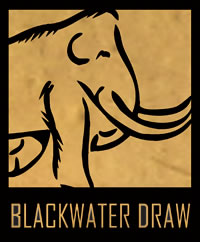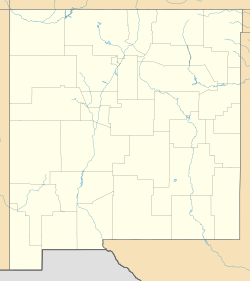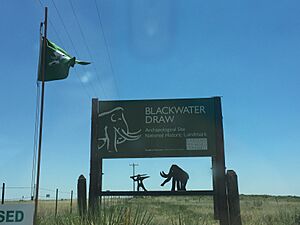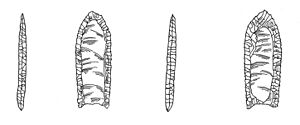Blackwater Draw facts for kids
|
Blackwater Draw
(Anderson Basin) |
|

ENMU museum and archaeological logo
|
|
| Nearest city | Clovis and Portales New Mexico |
|---|---|
| Area | 3,200 acres (1,300 ha) |
| NRHP reference No. | 66000483 |
Quick facts for kids Significant dates |
|
| Added to NRHP | October 15, 1966 |
| Designated NHLD | January 20, 1961 |
Blackwater Draw is a stream that sometimes has water flowing in it. It is about 140 kilometers (87 miles) long. It starts in Roosevelt County, New Mexico, near Clovis, New Mexico. The stream then flows southeast across a flat area called the Llano Estacado. It eventually reaches Lubbock, Texas. There, it joins another stream called Yellow House Draw. Together, they form Yellow House Canyon. This canyon is at the beginning of the North Fork Double Mountain Fork Brazos River.
Blackwater Draw goes through parts of eastern New Mexico and several counties in West Texas. It helps drain a large area of about 4,040 square kilometers (1,560 square miles).
Contents
Discovering Ancient Life at Blackwater Draw
Blackwater Draw is home to a very important archaeological site. This site is known as the Blackwater Draw National Historic Landmark. People first noticed its importance in 1929. A local person named Ridgley Whiteman from Clovis, New Mexico discovered it. The main part of the site, called Blackwater Locality No. 1, is where the famous Clovis culture was first identified.
Early Digs and Discoveries
Large-scale digging at the site began in 1932. However, local people had been finding old bones and stone tools for many years before that. In the 1960s, a person named Frank J. Brolio dug up a camp site nearby. This site was known as "Franks Folsom Site." He found a very large stone tool there. During this time, from 1952 to 1970, Blackwater Draw was also a place where people mined for gravel. While mining, they uncovered many places where ancient mammoths and bison were hunted.
In the 1980s, another part of Blackwater Draw was explored. This area was called the Mitchell Locality. It was a large camp site from the Folsom period. Many stone tools were found there. Some of these tools even had traces of bison and pronghorn blood on them.
Clovis Points and Ancient Hunters
At the Blackwater Draw site, archaeologists found special spearheads. These spearheads are called Clovis points. They were a new invention by early people in North America. Other stone and bone tools were also found. These tools were used for hunting, preparing food, and other daily tasks. Clovis points are usually long and shaped like a leaf. They are often longer than Folsom points.
The Clovis tools were found with the bones of very large animals. These animals lived a long time ago, during the Late Pleistocene period. They included huge mammoths, camels, horses, and ancient bison. There were also saber-toothed cats, giant sloths, and dire wolves. Early people who visited Blackwater Draw hunted these animals.
Many generations of the first people in North America camped and hunted at Blackwater Draw. Because of this, the site has many layers of archaeological remains. Each layer shows a different time period. These periods include Clovis, Folsom, Midland, Agate Basin, and various Archaic periods.
Understanding Ancient Technology
Clovis stone tool technology is one of the oldest and most widespread in North America. Scientists have used radiocarbon dating on the soil layers at Blackwater Draw. They found that the Clovis layers are about 11,290 years old. Two of the spear points found at Blackwater Draw were used to help define what Clovis stone tools look like.
The archaeological site is famous for its clear layers of soil and artifacts. These layers show how different cultures lived there over time. The story begins with some of the earliest people in North America. It continues through the Southwestern Archaic period and into more recent history. Studies at Blackwater Draw have even found traces of protein on Clovis weapons. This shows they were used for hunting and possibly butchering the large animals of the Ice Age.
Towards the end of the Ice Age, the climate started to change. It became warmer and drier. This caused the water in the area to dry up a lot. Small, seasonal lakes called playas formed. These areas became popular hunting spots for early North Americans. At that time, the site had many active springs. Many stone tools were found in the sandy areas around these springs. People think these tools were thrown into the springs. Some even suggest it might have been part of a special ceremony.
Since its discovery, Blackwater Locality No. 1 has been a key place for scientific research. Many important groups have studied the site. These include the Carnegie Institute, the Smithsonian Institution, and the National Geographic Society. Over a dozen major universities have also helped with research. Today, Eastern New Mexico University (ENMU) owns and manages the site. They also handle the excavations and visits.
The area around Blackwater Draw, known as the Anderson Basin district, covers about 3,200 acres. It is near Clovis and Portales. This area was named a National Historic Landmark in 1961. It was added to the National Register of Historic Places in 1966.
Blackwater Draw Museum
The first Blackwater Draw Museum opened in 1969. It was located in Portales, New Mexico. Its main purpose was to show artifacts found at the Blackwater Locality No. 1 site. The items on display showed what life was like at the site. They covered the Clovis period (over 13,000 years ago) up to more recent times.
In 2017, the museum moved to the Eastern New Mexico University (ENMU) campus. It also expanded its focus. Now, it includes local history and archaeology from many different places. The exhibits explain how archaeologists work. They also show different archaeological sites, cultural groups, and scientific methods. Visitors can learn more about Blackwater Draw and archaeology in general. They can also see items from the greater Southwest that came from private collections. For example, the Miles Collection shows Southwestern pottery, baskets, and textiles.
The museum and the Blackwater Draw site are managed by ENMU's Department of Anthropology and Applied Archaeology. Students studying anthropology at ENMU can work at the museum and site. They can be employees, interns, or volunteers. Anthropology students often use the museum's collections for class projects, research, and master's theses. Both the museum and the site host visits for ENMU students and K-12 school groups all year long.
See also







